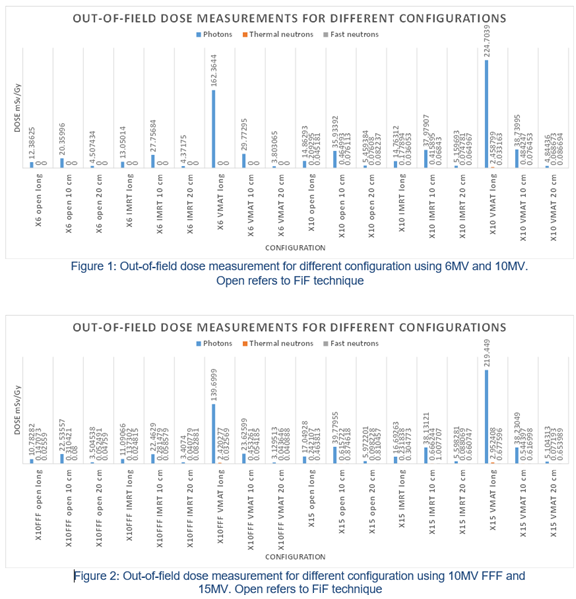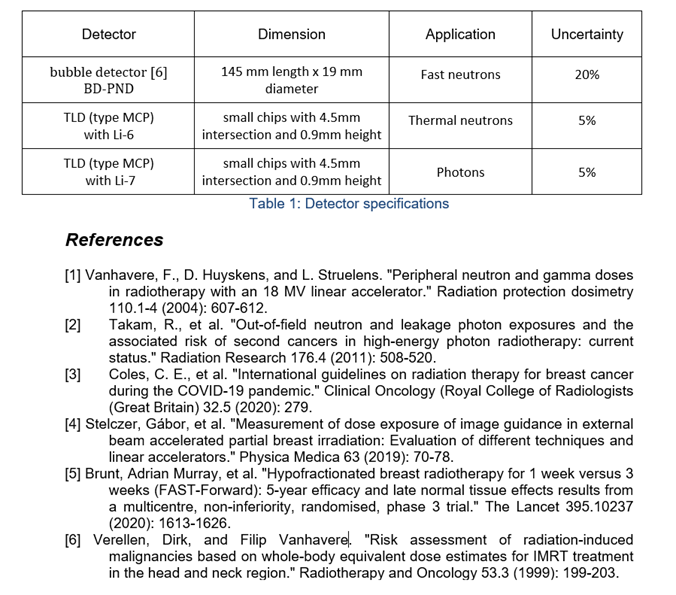Reassessment of neutron contamination during breast treatment for different configurations
PO-1519
Abstract
Reassessment of neutron contamination during breast treatment for different configurations
Authors: Ali Dabach1, Piet Steven1, Ahmed Taieb Mokaddem1, Marijke De Saint-Hubert2, Olivier Van Hoey2, Ibrahim Chiairi1, Melanie Machiels1, Philip Poortmans1, Dirk Verellen1
1Iridium Network, Radiotherapy, Antwerpen, Belgium; 2Belgian Nuclear Research Centre, Dosimetric Applications, Mol, Belgium
Show Affiliations
Hide Affiliations
Purpose or Objective
Early assessment of neutron contamination in IMRT applications was based on delivery techniques [1,2]. Recently these delivery techniques have been optimized and made more efficient with respect to the number of MU required for a certain dose. In fact, the number of MU for many IMRT or VMAT treatments required for a certain fraction dose are now comparable to those required for 3D-conformal techniques. Furthermore, with the Covid-19 pandemic, a new hypofractionated breast treatment protocol was introduced in our department, based on the “Fast Forward” protocol [3,5]. The implementation of higher daily doses demands for stricter constraints. This study was initiated in order to determine a strategy in minimising the out-of-field dose in clinical practice taking into account the risks and benefits related to different treatment techniques and photon energies.
Material and Methods
To simulate realistic clinical conditions, an anthropomorphic phantom was used with a right breast prosthesis. The phantom was scanned and appropriate structures (body, breast, lung and PTV) were delineated. Plans were created using Field in Field (FiF), IMRT and VMAT techniques with different energies. The mean dose of the PTV was normalised to the prescribed fraction dose (5.2Gy) in all treatment plans. Surface scanning was used to position the phantom for treatment. Different detectors types were used for measurements (see Table 1). The measurements were performed at 3 positions: one in the lung and two on the surface at 10 cm and 20 cm respectively from isocentre.
Results
Figures 1 and 2 illustrate the out-of-field dose measurements associated with a specific configuration of delivery technique and beam energy. Application of 15MV, for all delivery techniques combined, produced more neutrons compared to the other energies used in this study, the neutron contribution to the total contamination was up to 13% for 15 MV at 20 cm from isocentre. FiF neutron contribution were comparable to IMRT even if it required the least MU. In terms of photon scatter contribution, VMAT showed the highest doses. The neutron contamination for 10 MV and 10 MV FFF was similar. Considering a treatment fraction of 5.2 Gy delivered in 15MV IMRT mode, a neutron contamination of 5mGy was observed, which can be considered comparable to a CBCT acquisition for patient positioning [4].
Conclusion
As IMRT provides better dose homogeneity and OAR sparing it can be preferred over FiF considering comparable contributions in out-of-field dose contamination. For some complex cases, such as irradiating regional lymph nodes for a breast treatment, VMAT can be considered, as the small increase in out-of-field dose might be balanced against an optimal target coverage / OAR sparing. As expected, some neutron contribution can be observed for the higher energies, however, the low levels of it to the total contamination dose as observed in this study might warrant their use in favour of improved target coverage and skin sparing.
Appendix

